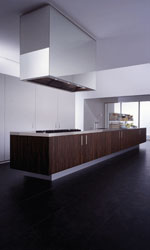
Interview

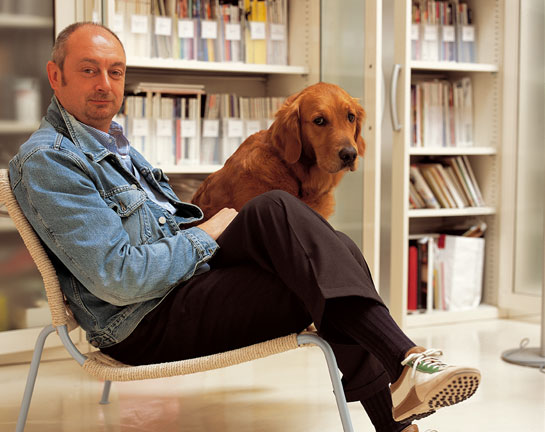
"Architects are dangerous people" Piero Lissoni
You work as an architect and a designer at one and the same time. Would you say that this broad spectrum -designing a building from its façade to its interior - is something typically Italian?
Yes, it is quiet typical of our Milanese attitude. But if you look around the world you discover another level of work. For many people buildings are just the outside face, but nobody bothers about the inside. After the architect you have an interior designer, and after the interior designer you have somebody doing what we call "superficial decoration" - flowers, objects and things like that. In my studio, however, we are involved in the entire process. We design the building and we design the flowers inside. I think this is more interesting, as you can pursue your ideas entirely and the client is also involved to a greater extent.
The attributes 'calm' and 'silent' would best describe your work. Is there a reason why you forgo the "loud"?
I like to design something that is to a greater or lesser extent clean and silent because this is my approach. However, although I prefer sophisticated minimal lines I accept some noisy design as well because otherwise it would be impossible to survive. But can you imagine the opposite, if everything were noisy? That would be a nightmare too. You have to combine things, and you have to accept this level of contamination. For ten years now, with computers and drawing systems as sophisticated as they have become,it has been possible to design things that are strange and out of order. The alternative would be to continue in a boring, clean and straightforward way. I have chosen the second path. I am not ultimately dangerous. But the other path is as dangerous as hell.
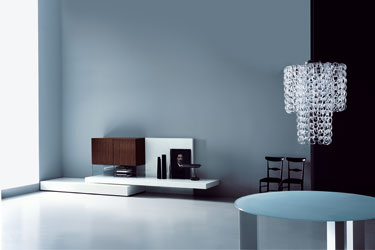
What do think about architecture today?
For me architecture adheres somewhat to the same strategy as design. Unfortunately, the dimensions are completely different. Some years prior architecture was shroudedin silence, ,total silence. If you look at fantastic architects like Toyo Ito, Shigeru Ban, SANAA or Kengo Kuma they have been producing incredible quality for twenty years, but without talking about it. Today designing just one chicken house is enough for a special book to be written about you, with magazines all around the world saying you are the new genius. I always say: First build ten different top-quality buildings and then we can talk about you. Architecture is about continuity.
And no star allures?
In that sense I am really more traditional, but in a respectable way. As architects and designers we are workers, not rock'n'roll stars. If you want to be a Mick Jagger type you have to change your line of work. You have to sing and to play guitar on a stage. Unfortunately for a lot of my colleges our work is like a show. You have to arrive dressed like a clown, you have to talk like a clown, you have to perform like a clown. Where is the quality in that?
But isn't it a problem today that designers need to catch people's eye at during fairs with more and more "crazy" things?
Definitively, for example during this year's Milan furniture fair I discovered a new level of transformation. There were tables that can be folded origami-style into a chair. And then you turn the chair into a bed and so on. What is that about? These are unbelievable, ugly and idiotic ideas. Unfortunately, however, a lot of people like it. As for me, I don't understand it, because I think it is just to be surprising. But if they want to be surprsinig they should go to the fair naked. That would be enough.
What do you think about the objects designed especially as single-pieces for the fairs but not for production?
When I think in my normal life I think as an industrial designer. But I understand this desire for unique pieces made for a special show. When, for example, Nadja Swarovski asked me to design a chandelier for this year's Crystal Palace, it was a bit beyond my range of vision. Because it requires more specialized thought in a more artistic way of life. So I changed the attitude of the one-show-piece into an industrial-show piece. I designed a chandelier for industrial production and not a single piece. It is possible now to repeat the chandelier as a single copy or one hundred thousand copies. I think that is the difference.
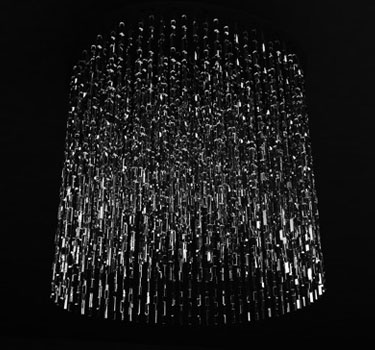
We are sitting here in your studio in Milan but at first sight it doesn't look at all like a typical architecture studio. The space is full of objects, pieces of art and typical home furniture like sofas and daybeds. Why is that?
I like to combine different layers of life. We have to think that in a way we are living in a very complicated time. And for that reason I like to transform one space such as professional space into human space. In this room you won't find a single computer, for example. You see books, you see objects, you see flowers and even something strange like my dogs.
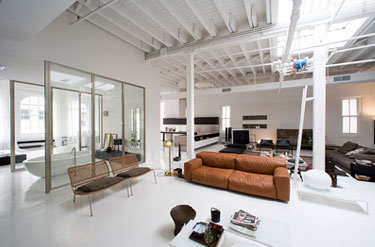
…which immediately creates the atmosphere of an apartment…
Yes, because when I decided to found this studio I had one idea in my mind: I don't want to open an office. I want to open a lounge. Unfortunately we have to work on a table because it is not possible to work on a sofa. That's why my studio is more or less like a confused lounge - maybe a little bit out of order - but for me it is like a lounge. For that reason I like to have my dogs around, to change the classic cool working atmosphere. For example we don't use the classical meeting rooms. We only have two libraries. It's possible to study, to read, to talk - a mixture of atelier and university in a way. For that reason it has strange energies inside. But for me it is fantastic.
How many people work in your studio at the moment?
At the moment we are about 75. We do not speak Italian because more than 50 percent of the employees are foreigners. So we have to use another language. It is open day and night, because I am not a fan of classic office rules, when you have to come at nine in the morning and you have to finish at six in the evening. My office is completely relaxed. There are no fixedhours. Everybody is free to come and go as they like: day, night, morning and afternoon. We only have some set times during the day for meetings. Unfortunately sometimes I fix a meeting and I'm not there - but that's another story.
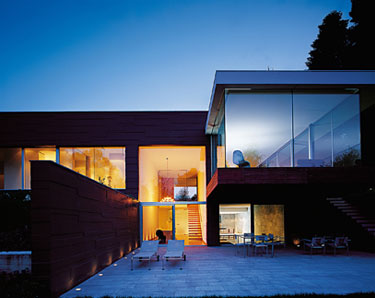
How is the structure organized? Do architects and designers work separately?
Yes, we have divided everything uo on different levels. The first floor is for graphic design, the ground floor for architecture and industrial design and downstairs there is just architecture. I put the architects downstairs because for me they are the most dangerous people in the world. If you design something like a chair or a table and the design is not good you will not destroy anything. But if you design something wrong in a building you destroy life for everybody. For that reason I put the architects downstairs - near to hell. Watever the case you have to take care of them.
How much of your work is design and how much is architecture?
The structure of the office is divided up into 30 percent graphic design, 35-40 percent architecture and the rest in design. Sometimes I think design is like driving a formula one car, so fast, and very dangerous. Architecture is quiet different. The process is very long and for that reason I use more energy for architecture. We have a lot of architecture projects at the moment.
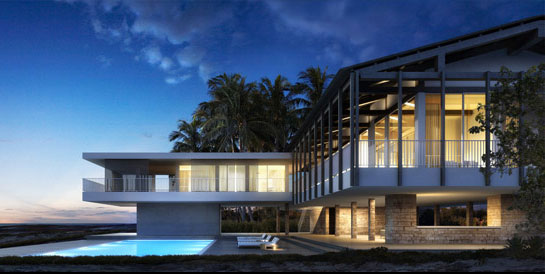
Can you give some examples?
On Dellis Cay for example, one of the Turks & Caicos Islands in the Caribbean, we designed a new hotel, residences and some beach villas. Construction work has just started and I hope we will be finished on time in two years. But we have a lot of different buildings all around the world. We have projects in New York, Dallas - a horrible, ugly city -, Miami, Amsterdam, Jerusalem, Dubai, and in Japan. Some of them are residential buildings, others are factories or headquarters, like the one we did for the furniture company "Living Divani". But at the end of he day all these projects are very different because I don't like the idea of designing architecture in series. I never design a building and repeat the same building in another place. A building is always specific to its place.
I heard you are also working on some yachts at the moment…
Yes, for example I designed a beautiful sailing boat for a private client. It is 36 meters long and 4.6 meters wide, a beautiful state-of-the.art carbon sailing boat like the ones used for the America's Cup. And we have just finished a 52-meter motorboat for an Italian client. But it is a motorboat. Just now we are starting work on the design of another boat, which is going to be around 90 meters long. It is like a small petroleum tank with a quiet military shape. I designed everything - the shape of the body, the interior, everything. For me it is like a building, a floating building under special conditions. The design is very pure and simple, not like these classic huge bright white boats full of strange lines.
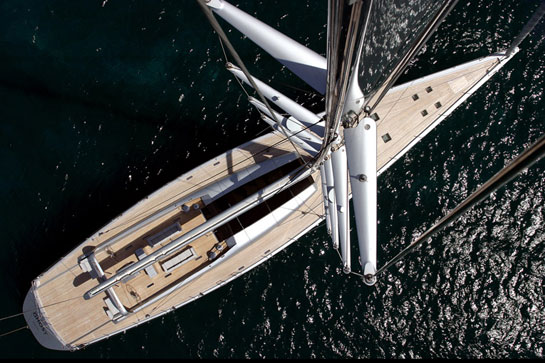
When you are working on new projects how do you proceed?
You have to reverse the process and think a lot beforehand. Even when you are in a design process for several years you can fix an idea in your mind in just three seconds. But the idea is just as fast in your mind because before you are working, you are talking or you are sharing your ideas with somebody for example from a factory. When I have an idea I then start to make a prototype and than we change it again and again - sometimes up to twenty times, which of course is a nightmare for the poor producers. I use simple products, pretty much the same system as for much more complex products. But for a kitchen for example it's different because I don't design only the kitchens. Beforehand I design a special rituality, the rituality of life aroundit . And after that I try to design the aesthetics of this rituality.
With regard to the new kitchens you designed for Boffi this year you also worked with specially aged materiality.
Yes, I tried to use natural, chic and shabby materials together. I like to use cutting-edge materials plus these tasteful materials all together. It is a bit provocative. I used this very old wood and I put it on top of a sophisticated stainless steel top. Again, it is about the contrast, because nowadays in kitchens everybody works around the image of simplicity and technological ideas. I tried to use the image of a professional kitchen and added some chic and shabby materials. It is a contamination and a connection at the same time.
A composition of different atmospheres…
Yes, many years ago Ray and Charles Eames continually talked about and published on the idea of connections. I try to follow them and like to connect different worlds, different materials and different histories at the same time. I am like a child. All my work is like a playground. When I design a chair for example for me it is like a toy. I am playing with it, and after two years I give it away. I am just a big child.
Thank you very much for talking to us.
Norman Kietzmann studied industrial design in Berlin and Paris and is writing as freelance journalist on architecture and design for Baunetz Designlines, Deutsch, Plaza, Odds and Ends and others.












































